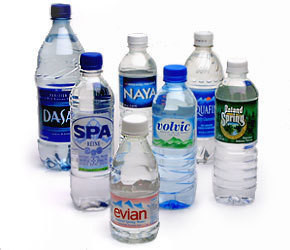Stop Drinking Bottled Water

Tammy has been leading the way on a number of environmentally conscious improvements in our house. We’ve done a lot of big things like our solar heat project and buying wind credits for all of our electricity. But these larger efforts are somewhat “mailing it in”. You do them once, write a check to someone, and continue as you always have. They don’t require you to change behavior at all. Recently we’ve been working harder on these types of change, including starting to compost and using air conditioning more sparingly. Tammy however has been pushing even farther, looking at where she buys clothing, where items comes from and what we bring into the kitchen.
Over the last year or so we’ve weened ourself off of the traditional grocery stores. We’ve been longtime co-op members and shop at Lakewinds. However, for a long time we supplemented with occasional trips to “normal” grocery stores for other items. We no longer do this, having pushed those items out of our kitchen. We can happily report there are no trans-fats, and no high-fructose (or otherwise) corn syrup products in our house. Shopping exclusively at a co-op makes this much easier to do. We recently got new sheets for our bed and she persisted her search there. She found bedsheets made of bamboo that have a much smaller footprint on the environment. By the way, the bamboo sheets are awesome.
She has recently declared no more bottled watter. She read Garbageland a while ago and that really got her thinking about trash (hence our push into composting) and bottled water is a huge problem in this regard. We now all have our Sigg bottles and eschew the ubiquitous bottled water in favor of bringing our own along. The September 7th edition of The Week goes into much more detail on this problem in it’s briefing entitled The High Price of Bottled Water. Here are some highlights I felt needed to be shared.
- In 2006 American’s consumed 30 billion bottles of water spending $15 billion. Think of those 30 billion water bottles in landfills. Only 25% of them are recycled. (Okay, 22.5 billion water bottles in landfills.) That’s 2 billion pounds of plastic.
- 75% of New Yorkers when given a blind taste test prefered New York city tapwater to bottled water.
- EPA standards for city water are more strict than FDA standards for bottled water. For example, city water is tested 100 or more times a month for coliform bacteria, and bottled water once a week.
- It takes 1.5 million barrels of crude oil to create the plastic bottles. 37,800 18-wheelers are in use every day to haul bottled water around the US.
- If you paid for your tap water at the same rate you pay for bottled water, your water bill would cost $9,000 a month.
The only value being provided here is convenience. The water isn’t better. It’s just in a nice, convenient package. A simple change in behavior could help us out in so many ways.
I’ll be carrying my Sigg bottle more often… get yourself one!